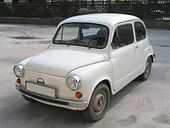Zastava 750
| Zastava 750 | |
|---|---|
 | |
| Overview | |
| Manufacturer | Zastava Automobili |
| Also called |
Fiat 750Z Fića, Fićo, Fičo Fičko, Fikjo |
| Production | 18 October 1955–18 November 1985 |
| Assembly | |
| Body and chassis | |
| Class | Subcompact |
| Body style | 3-door hatchback |
| Related | Fiat 600 |
| Powertrain | |
| Engine |
|
| Transmission | 4-Speed Manual gearbox[1] |
| Dimensions | |
| Wheelbase | 2,010 mm (79.1 in)[2] |
| Length | 3,300 mm (129.9 in)[2] |
| Width | 1,390 mm (54.7 in)[2] |
| Height | 1,410 mm (55.5 in)[2] |
| Curb weight | 640 kg (1,411 lb)[2] |

The Zastava 750 (Застава 750) was a car made by the Serbian car maker Zavod Crvena Zastava in Kragujevac. It was a version of the Fiat 600 made under licence from 1965, it was longer in length than the Fiat version. The Zastava 750 has a 767 cc (46.8 cu in) engine, which produces 25 PS (18.4 kW). The more powerful 750 SE has 30 PS (22.1 kW) at 5400 rpm and torque is 38 lb·ft (52 N·m) at 3600 rpm.[2] It is the smallest car ever made by Zastava. Later on during production, in 1980. the Zastava 850 was introduced, it featured the same body as the Zastava 750 but the engine had a larger capacity. The Zastava 850 is harder to find than the 750 model but both are still widely available in former Yugoslavia.
Zastava 750 is widely known by its nickname "Fića" (Фићa) or "Fićo" (Фићo) in Serbian, Montenegrin, Croatian and Bosnian, by "Fičo" or "Fičko" in Slovene and by "Fikjo" (Фиќо) in Macedonian. The nickname "Fića" comes from the main character of a comic published by the newspaper Borba during the first years of the car's production.
Development
The 750 retained suicide doors until 1969. Later it got bigger front lights, autoadjusting brakes, seatbelts, slightly improved interior and many other small improvements. The later Zastava 850 had many improvements from the original model, but it retained the same body style, and should not be confused with the Fiat 850. Like the Fiat 850, it is largely derived from the 600, but introduces a fully synchronized transaxle, front disc brakes, and an alternator. The Fiat 850 is thus a popular source of 'upgrade' parts for the 600, but these upgrades can be difficult or costly as few of the parts can simply be exchanged without modification. The 750 used a 25 hp (30 hp in the 750 SE) 767 cc engine, while the 850 received an 848 cc version providing 32 hp and a useful dollop of extra torque.
Production of the Zastava 750 began on 18 October 1955 and ended on 18 November 1985. The car's popularity has started increasing in the last years, partly from the low fuel consumption and very cheap price as a second hand vehicle. Also it starting to become a symbol for nostalgia, and many youngsters that need cheap utilitarian vehicle with a bohemian status symbol are buying this car as a second hand vehicle. Because of that prices have risen in the last couple of years and many fan clubs have emerged.
Colombian assembly
The Zastava 750 was also assembled in Colombia - next to a variety of American Jeeps as well as other Fiat models - by Leonidas Lara (C.C.A.) in Bogotá.[3] It was sold in Colombia as the "Fiat 750Z", from 1977 until 1984.
References
- ↑ http://www.automobile-catalog.com/make/zastava/750_zastava/750_zastava/1964.html
- ↑ 2.0 2.1 2.2 2.3 2.4 2.5 "1979 Zastava 750 Specs". CarQueryAPI. Retrieved 2013-10-29.
- ↑ Munar Guerrero, Laura Cristina; Quiroga Porras, Johana Patricia; Peña Mayorga, Manuel Fernando (2012-10-09), Análisis estratégico del sector automotriz en Colombia [A strategic analysis of Colombia's automotive sector] (in Spanish), Bogotá, Colombia: Universidad del Rosario, p. 10
| Zastava, a subsidiary of Fiat Group since 2008, road car timeline, 1955–2008 | |||||||||||||||||||||||||||||||||||||||||||||||||||||||
|---|---|---|---|---|---|---|---|---|---|---|---|---|---|---|---|---|---|---|---|---|---|---|---|---|---|---|---|---|---|---|---|---|---|---|---|---|---|---|---|---|---|---|---|---|---|---|---|---|---|---|---|---|---|---|---|
| Type | 1950s | 1960s | 1970s | 1980s | 1990s | 2000s | |||||||||||||||||||||||||||||||||||||||||||||||||
| 5 | 6 | 7 | 8 | 9 | 0 | 1 | 2 | 3 | 4 | 5 | 6 | 7 | 8 | 9 | 0 | 1 | 2 | 3 | 4 | 5 | 6 | 7 | 8 | 9 | 0 | 1 | 2 | 3 | 4 | 5 | 6 | 7 | 8 | 9 | 0 | 1 | 2 | 3 | 4 | 5 | 6 | 7 | 8 | 9 | 0 | 1 | 2 | 3 | 4 | 5 | 6 | 7 | 8 | ||
| City car | 600 | ||||||||||||||||||||||||||||||||||||||||||||||||||||||
| 750 | |||||||||||||||||||||||||||||||||||||||||||||||||||||||
| 850 | |||||||||||||||||||||||||||||||||||||||||||||||||||||||
| Subcompact | Koral | ||||||||||||||||||||||||||||||||||||||||||||||||||||||
| 10 | |||||||||||||||||||||||||||||||||||||||||||||||||||||||
| Compact | Skala | ||||||||||||||||||||||||||||||||||||||||||||||||||||||
| 128 | Florida | ||||||||||||||||||||||||||||||||||||||||||||||||||||||
| Mid-size | 1300/1500 | ||||||||||||||||||||||||||||||||||||||||||||||||||||||
| LCV | Rival | ||||||||||||||||||||||||||||||||||||||||||||||||||||||
| Wikimedia Commons has media related to Zastava 750. |